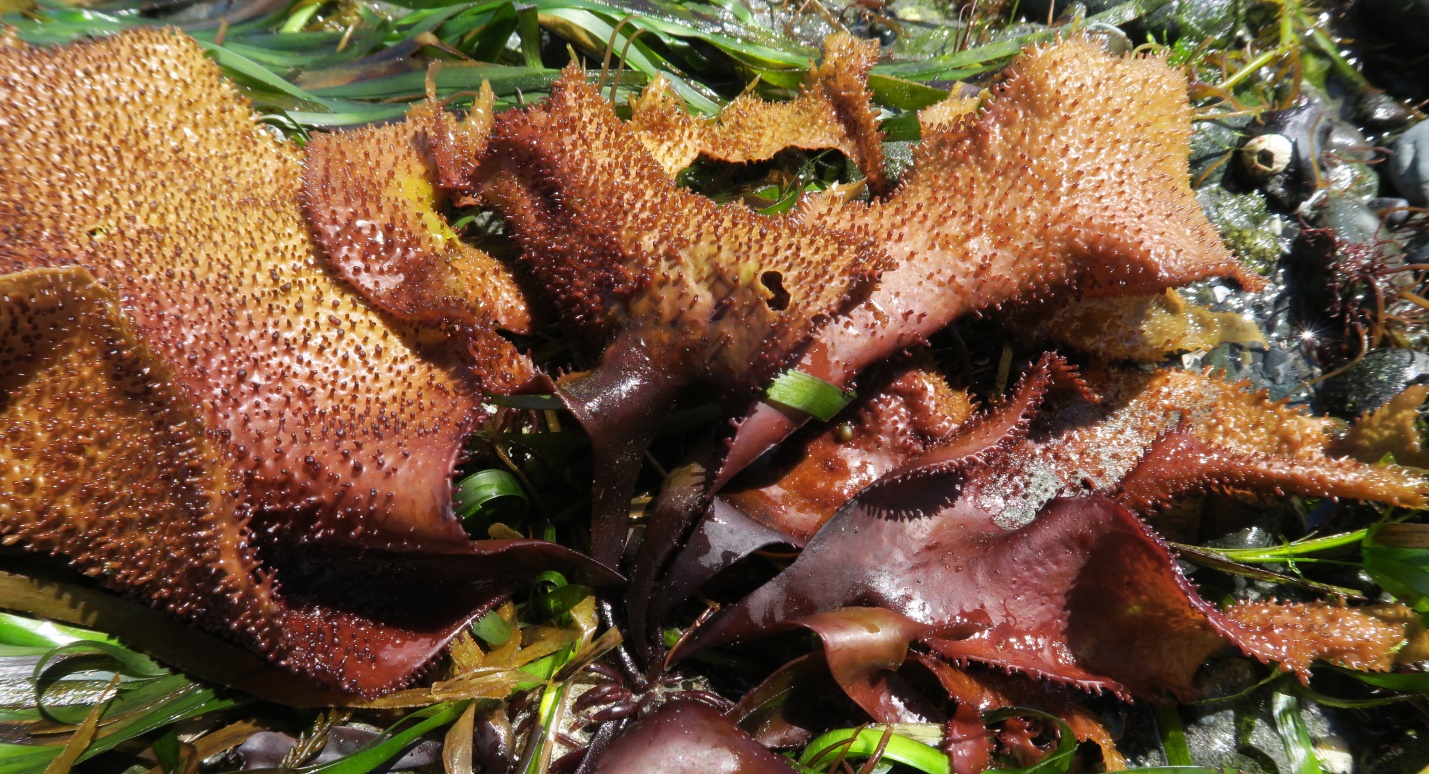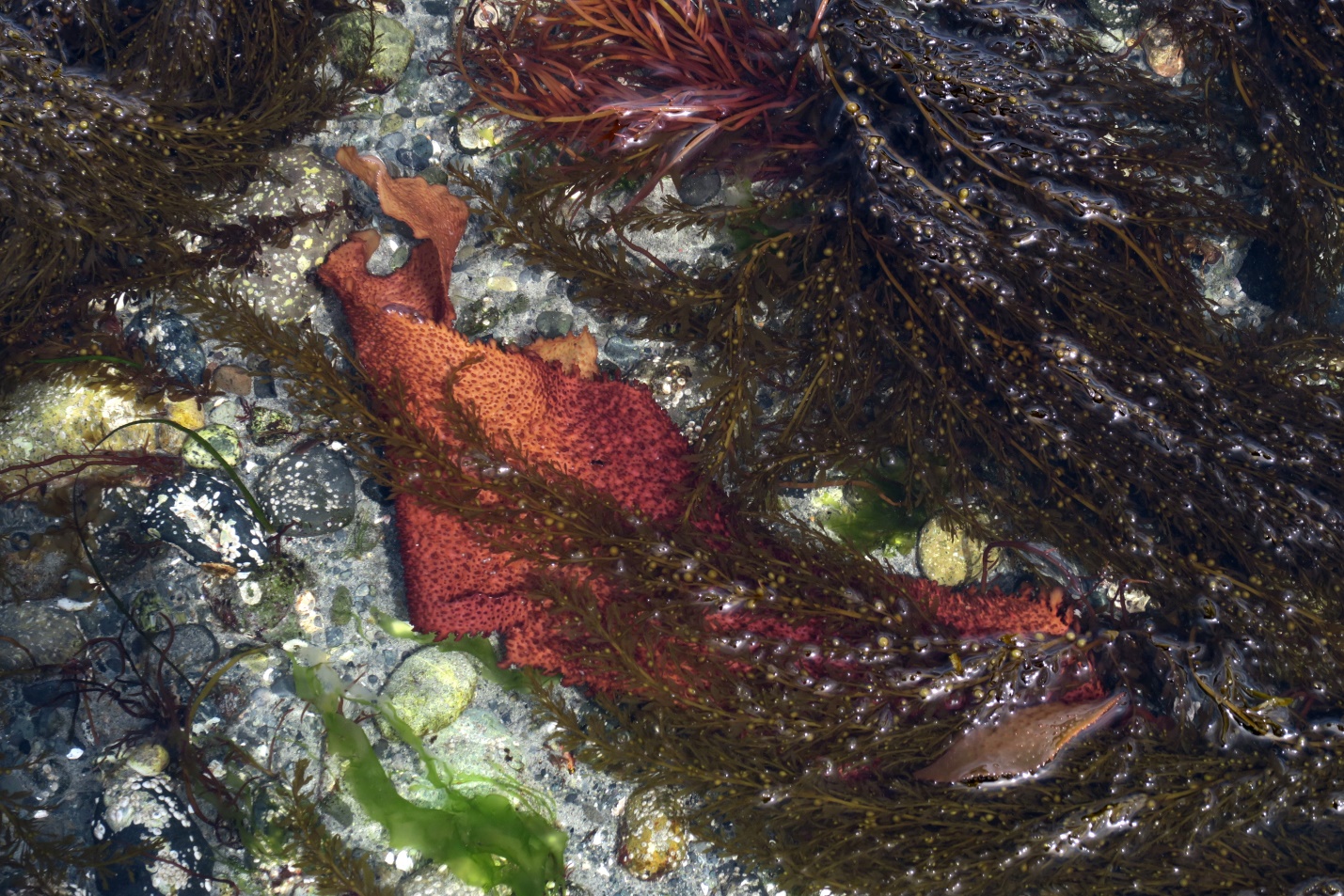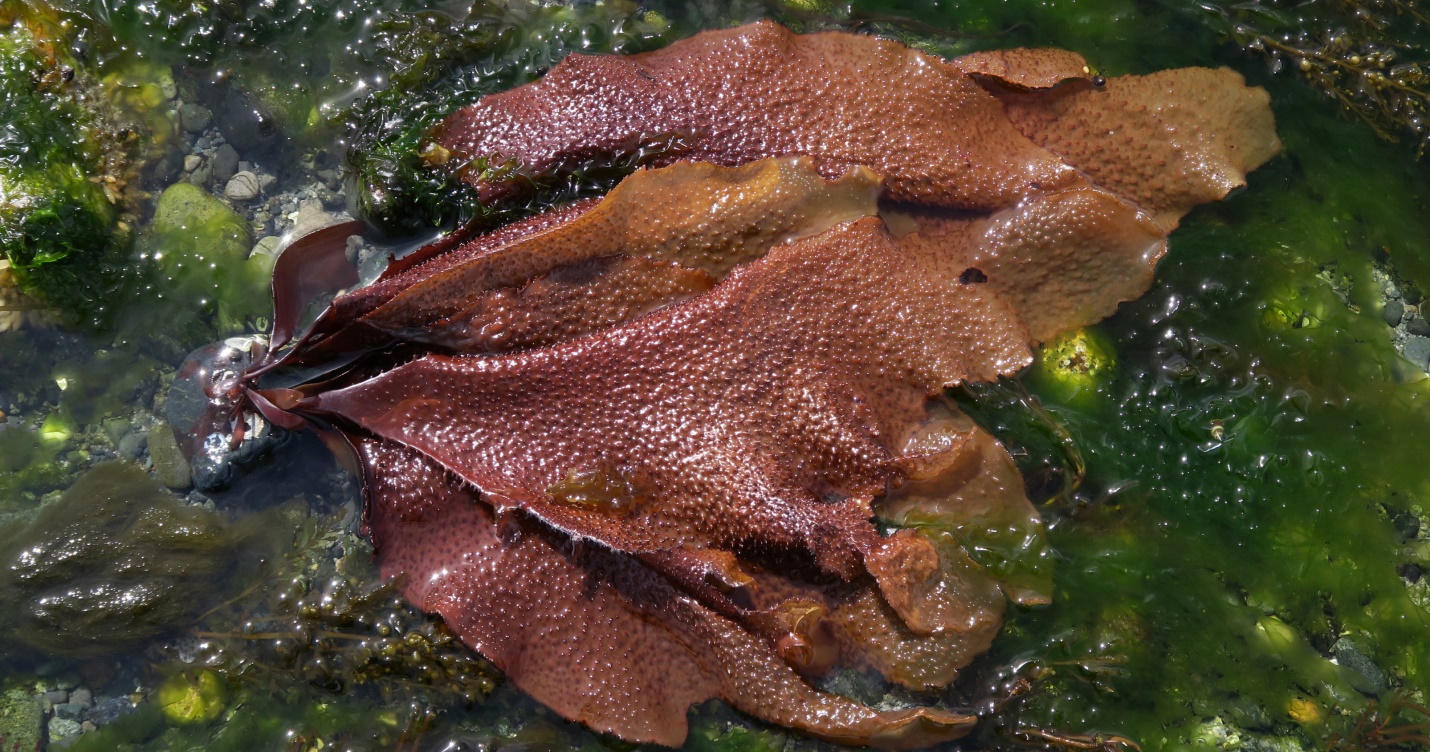
Chondracanthus exasperatus
Turkish Towel
Interactions conducted: 24 June 2021, (start time 11:50am PDT)
Little Qualicum Estuary, Strait of Georgia, BC, Canada.
Tide: 0.3 foot tide 11:59am PDT (measured at Winchelsea Islands Tidal Station)
Conditions: Mostly clear (10% cloud cover), no precipitation, wind NE 15 km/hr, light chop, 22˚C.
Phase of Moon: Waning Gibbous (approx. 10 minutes into this phase at time of interaction); (Previous Phase, Full Moon, 24 June 2021 at 11:39am PDT: Next Phase, Third Quarter, 1 July 2021 at 2:10pm PDT.)

Figure 1: Chondracanthus exasperatus; Little Qualicum River Estuary, Strait of Georgia. 24 June 2021. Photo ID 27189 ©Seaweedwhisperings.com
Person 1:
Overall appearance is of reptilian skin, though not scaly.
Papillae form a rough covering, like a knobby scrub brush. Pleasing and a bit ticklish to touch with my finger.
Flat blades have irregular edges.
Purple-y red coloration, bleaching to light olive brown.
Small hold fast.
Fun to play with.
I rubbed the blade on my face, very enjoyable.
Bi-polar, can turn mean if play isn’t by its rules.

Figure 2: A yellow-red blade of Chondracanthus exasperatus wafting in the surf along with a bit of bright green Ulva linza, rather a lot of the brown alga, Sargassum muticum and at center top also some Sarcodiotheca gaudichauii. Little Qualicum River Estuary, Strait of Georgia. 29 April 2021. Photo ID 27190 ©Seaweedwhisperings.com
Person 2:
Blades are random oval shaped but often terminate in two or three rough points.
Reminds me of a lobster claw or crab pincer.
More so than your shape, your TEXTURE is really outstanding. Bumpy papillae are ALL over both sides of the blade and trimming your margins.
Out of water your papillae are almost grippy, like some sort of non-slip rubbery product.
Blade is thick-ish, about 1mm, and your papillae extend 1.5 to 2mm beyond on both sides. These papillae create a lot of surface area on your blades.
Clusters of the blades arise from holdfast anchored on a cobble.
Six of you at this cluster- one very large (40cm long), two medium (18cm long) and three much smaller in overall size.
Your color ranges from deep purple-brown to yellow olive-green – but papillae color is mostly brownish. Overall this can even make you look orange-y in color.
Visually, you stand out – dominate.
You
are down at the lowest above tide area (here today on a very low tide
day).
I feel a little pressed for time. Like this encounter
may have to be cut short.
You, however, seem not pressured at all! Splayed out on eelgrass, you are just waiting for the surf to return to you.
Under water your bumpy surface is slippery and all I can feel are the tips of the papillae, they stand out; the flat base/surface of the blade cannot be touched by anything nearly as large as my finger.
What is at your core, beneath these sticking out papillae?
Base of blade has a short, flattened stipe. Here the blade is smooth and thick and tough like hardened leather.
I think you are difficult to understand.
Or, maybe you’ve had to armor up, toughen up, and I would just need to be patient, be gentle, and get to know you as you care to show me yourself.
A ruffle here, another one there, countless papillae, differing colors, a ragged overall shape, varying sizes of blades – your characteristics really are varied and overall the effect is rather extravagant and also not very beautiful. You attract attention, however if anything stands out about your looks it is that you present in a rather grotesque manner. You are not beautiful or in any way pretty, you look misshapen or malformed or like you can’t make up your mind what form you want to have.
One blade looks like a prickly pear cactus pad with smaller pads at the top. Another blade looks like a crab pincer. Yet another blade looks quite different again.
Blades are thick but limp – you have no backbone or “spine”.
You don’t resist proactively, you just make it quite difficult or fairly unappealing to interact with you.
There are not many of you in this area; is this a marginal place for you to live, or do you each need room, lots of space; do you repel others of your kind?
Discussion:
Person 2 noted about this seaweed “difficult to understand”, and it seems that you can get to know them when and only if and just to the extent that they care to reveal themselves. Thinking about this it appears that Person 1 didn’t “get to know” this seaweed much at all. He reports that he actually wandered around to find other individual Turkish Towels, ostensibly to see if he could understand a little more. That effort, for him on this day, felt unsuccessful except for his perception that there is a notable reaction – they could “turn mean” if things do not go as they want them to go. This links with the concept of dominance; there is an understandable reluctance on the part of others to abide with this ‘mean’ quality. So, in relationships, if there is interaction the Chondracanthus ‘way’ will dominate.

Figure 3: Big, thick and rubbery textured blades stand out against, Ulva linza and Sargassum muticum and eelgrass – visually striking, dominant. April 29, 2021. Photo ID 27191 ©Seaweedwhisperings.com
Biology & Natural History Information:
Description:
The blade of this red seaweed is tough, thick to somewhat rubbery texture. It can be varied in color ranging from pinkish to purplish, reds from quite pale to much darker, brownish or even yellow green depending on exposure and location along its range. Younger blades may be iridescent when wet. Both sides of the blade are covered in small numerous lollipop-shaped papillae; these are so profuse that it does impart a ‘towel-like’ texture. The entire thallus may grow between 50cm and 80cm long and about 20 to 30cm wide; it is usually oval to lanceolate in shape, but in the northern part of its range it can be somewhat irregular and jagged in outline. Normally a maximum of two or sometimes three blades grow from a short flat stipe which arises from a small discoidal holdfast.
Habitat:
Common on rocks in the low intertidal and shallow subtidal.
Distribution:
Sitka Sound, Alaska to Baja California, Mexico.
Remarks:
Wave exposure impacts blade thickness in Chondracanthus exasperatus; Turkish towel has thinner blades when growing in sheltered habitats. Those growing in more exposed areas have blades that are thicker and even somewhat stiff. This species is a source of carrageenan, a stabilizer for a wide range of human food products including cottage cheese and even things like printer’s ink; it has been experimentally farmed for this purpose.
Classification:
Phylum: Rhodophyta
Class: Florideophyceae
Order: Gigartinales
Family: Gigartinaceae
Genus: Chondrcanthus
Species: Chondracanthus exasperatus (Harvey & Bailey) Hughey 1996
Former name(s): Gigartina exasperata Harvey et Bailey; G. californica J. Agardh

Figure 4: A few other blades of Turkish Towel seaweed – younger, differently shaped, not beautiful to most people’s tastes, but rather distinctive and striking just the same. June 24, 2021. Photo ID 27192 ©Seaweedwhisperings.com
![]()